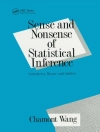‘This book is a rich source of information on the application of relapse prevention with sex offenders. It presents readers promising directions for change and areas that need revision based on new research findings and the integration of emerging theoretical models that show considerable promise in this field. . . . The material in this book should help us construct a better, safer vehicle for the treatment of sex offenders in the new millennium.’
–from the Foreword by G. Alan Marlatt, University of Washington
It is estimated that relapse prevention methods are employed in more than 90% of all North American sex offender treatment programs (of which there are more than 2, 000). Comparable statistics are true in most industrialized countries around the world. Over the last decade a great deal has been learned about the treatment of sexual offenders, and particularly about relapse prevention. This sourcebook provides clinicians with the most current, practical information about working with sex offenders to prevent relapse. It reflects the advances and insights of the past decade since the publication of Relapse Prevention with Sex Offenders , focusing on the major reconceptualizations, revisions, and innovations that will chart treatment programs for the first decade of the new millennium.
Table of Content
PART ONE: RELAPSE PREVENTION IN HISTORICAL PERSPECTIVE
The Original Model of Relapse Prevention with Sex Offenders – D R Laws, Stephen M Hudson and Tony Ward
Promises Unfulfilled
PART TWO: A REVISIONIST CRITIQUE
What Is so Special about Relapse Prevention? – R Karl Hanson
Do Relapse Prevention Components Enhance Treatment Effectiveness? – W L Marshall and Dana Anderson
Relapse Prevention and Harm Reduction – Susan A Stoner and William H George
Areas of Overlap
PART THREE: CONCEPTUAL AND CLINICAL REVISIONS
A Self-Regulation Model of Relapse Prevention – Tony Ward and Stephen M Hudson
Relapse Prevention – Stephen M Hudson and Tony Ward
Assessment and Treatment Implications
Behavioral Economics – William O′Donohue, Tamara Penix and Erin Oksol
Understanding Sexual Behavior, Preference and Self-Control
PART FOUR: CLINICAL INNOVATIONS: ASSESSMENT AND TREATMENT
Empathy Inhibition, Intimacy Deficits and Attachment Difficulties in Sex Offenders – Kurt M Bumby
The Role of Cognitive Distortions in Relapse Prevention Program – Calvin M Langton and W L Marshall
Managing Resistance and Rebellion in Relapse Prevention Intervention – Ruth E Mann
Complementing Relapse Prevention with Medical Intervention – Don Grubin
Competency-Based Assessment – Michael H Miner
Contextual Issues in Relapse Prevention Treatment – Yolanda M Fernandez and W L Marshall
External Supervision – Georgia F Cumming and Robert J Mc Grath
How Can It Increase the Effectiveness of Relapse Prevention
PART FIVE: SEXUAL PREFERENCE ASSESSMENT
Remaking Penile Plethysmography – Robert J Konopasky and Aaron W B Konopasky
Polygraphy – Michael A O′Connell
Assessment and Community Monitoring
The Abel Screen – Lane Fischer
A Non-Intrusive Alternative?
PART SIX: PROGRAMS: MAJOR INTERVENTIONS USING RELAPSE PREVENTION
Preventing Relapse in Sex Offenders – Janice K Marques et al
What We Learned from SOTEP′s Experimental Treatment Program
An Evidence-Based Relapse Prevention Program – Ruth E Mann and David Thornton
PART SEVEN: RELAPSE PREVENTION APPLIED TO SPECIAL POPULATIONS
Relapse Prevention with Adolescent Sex Offenders – William D Murphy and I Jacqueline Page
Treatment of the Developmentally Disabled Sex Offender – James L Haaven and Emily M Coleman
Relapse Prevention with Sexual Murderers – Joanna Clarke and Adam J Carter
Replacing the Function of Abusive Behaviors for the Offender – Hilary Eldridge and Jacqui Sradjian
Remaking Relapse Prevention in Working with Women Who Sexually Abuse Children
Holism, Wellness and Spirituality – Lawrence Ellerby, Jacqueline Bedard and Shirl Chartrand
Moving from Relapse Prevention to Healing
PART EIGHT: THE BOTTOM LINE
Maintaining Relapse Prevention Skills and Strategies in Treated Child Abusers – Anthony Beech and Dawn Fisher
How Does Recidivism Risk Assessment Predict Survival? – Jean Proulx et al
Treatment Outcome and Evaluation Problems (and Solutions) – R Karl Hanson
PART NINE: THE WAY FORWARD
Wither Relapse Prevention – Stephen M Hudson, Tony Ward and D Richard Laws
About the author
Tony Ward, Ph D, Dip Clin Psyc, is the Director of the Forensic Psychology Programme at the University of Melbourne. He was previously director of the Kia Marama Programme for sexual offenders at Rolleston Prison, Christchurch, New Zealand. His research interests include the offense process in offenders, cognitive distortions and models of rehabilitation. He has published over 110 research articles, chapters and books. These include Remaking relapse prevention, Sage, (with D.R Laws and S. M. Hudson, 2000) and the Sourcebook of treatment programs for sexual offenders, Plenum (with W. L. Marshall, Y. A. Fernandez, and S. M. Hudson, 1998). He is currently working on a book on theories of sexual offending and rehabilitation (Wiley).












